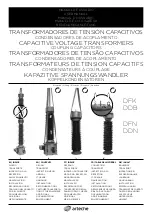
33
SPEKTRUM NX6 • TRANSMITTER INSTRUCTION MANUAL
EN
V-Tail Differential
Only available in Sailplane Type when V-Tail A or V-Tail B is active. See
SAIL
(Sailplane) section for set up.
Camber Preset
Only available in Sailplane Type when a 2+ aileron wing type is selected. See
SAIL
(Sailplane) section for set up.
Camber System
Only available in Sailplane Type when a 2+ aileron wing type is selected. See
SAIL
(Sailplane) section for set up.
Flap System
Only available in Airplane Type when a flap-enabled wing type is selected. See
ACRO
(Airplane) section for set up.
Pitch Curve
Only available in Helicopter Type. See
HELI
(Helicopter) section for set up.
Swashplate
Only available in Helicopter Type. See
HELI
(Helicopter) section for set up.
Gyro
Only available in Helicopter Type. See
HELI
(Helicopter) section for set up.
Tail Curve
Only available in Helicopter Type. See
HELI
(Helicopter) section for set up.
Motor Cut
Only available in Multicopter Type. See
MULTI
(Multicopter) section for set up.
Motor Curve
Only available in Multicopter Type. See
MULTI
(Multicopter) section for set up.
The following menu options are only available when they are enabled from the Model Type screen.
Mixing allows control input for a channel to affect more than one
channel at a time. Mixing functions support:
• Mixing a channel to another channel.
• Mixing a channel to itself.
• Assigning offset to a channel.
• Linking primary to secondary trim.
These mixes are available for each model memory:
When you choose a new programmable mix you can select from
either a normal mix or a curve mix. Specialized mixes will populate
the mixing menu, and change based on aircraft type and wing
type selections. Each specialized mix has specific features for its
intended function.
• 6 programmable mixes
• Cyclic to Throttle (HELI)
• Swashplate (HELI)
• Elevator to Flap (ACRO)
• Aileron to Rudder (ACRO)
• Rudder to Aileron/Elevator (ACRO)
• Aileron>Rudder (SAIL)
• Aileron>Flap (SAIL)
• Elevator>Flap (SAIL)
• Flap>Elevator (SAIL)
On the second line select a channel for master control on the left
and slave on the right. Inputs for the master channel control both
the master and slave channels. For example, Throttle > Rudder
makes Throttle the master channel and Rudder the slave channel.
A channel monitor at the bottom of the screen shows how
channels respond to input during setup. To view a mix on the
monitor, the mix switch must be in the active position or the switch
set to ON.
Rate
Change the rate value to control the travel and direction (positive or
negative value to reverse) of the slave channel.
Offset
Change the Offset value to move the effective center position
of the slave channel. Positive or negative value determines the
direction of the offset. Offset is not available for curve mixes.
Trim
If the master channel trim should also adjust the slave channel, set
Trim to Act.
Curve (Page)
The Curve value corresponds to each page of values assigned to
a switch position. Leave the Curve value matching the highlighted
box below the switch position for a basic configuration.
Switch
Select the switch you wish to use to activate the mix. The black
box indicates the switch position where the currently displayed
curve page is active, and the tick below the boxes indicates the
current switch position.
Select ON if you wish to activate the mix full time and do not want
to use a switch.
Tip:
Use Auto Switch Select to select the switch.
CAUTION:
Always do a Control Test of your model after
changing mixes.
FUNCTION LIST
Mixing
Normal Mix
















































